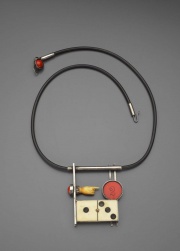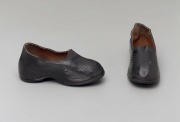Difference between revisions of "Rubber (synthetic)"
(username removed) |
|||
| (14 intermediate revisions by 2 users not shown) | |||
| Line 1: | Line 1: | ||
| − | [[File:52.1315a-SC14960.jpg|thumb|' | + | [[File:2006.551-SC179216.jpg|thumb|Necklace with rubber cord<br>MFA# 2006.551]] |
| + | [[File:52.1315a-SC14960.jpg|thumb|Children's rubbers<br>MFA# 52.1315a]] | ||
== Description == | == Description == | ||
| − | Any man-made [ | + | Any man-made [[elastomer|elastomer]]. The development of synthetic rubbers was stimulated when rubber imports ceased in 1941 due to Japanese occupation in southeast Asia. Within 3 years, US manufacturers had developed over nine types of elastomers. Most age better than [[Rubber (natural, vulcanized)|natural rubber]] but are still susceptible to degradation by [[ozone|ozone]] and [[ultraviolet%20radiation|ultraviolet light]]. All rubbers must be chemically vulcanized to form an stable product. The unsaturated materials are [[vulcanization|vulcanized]] with [[sulfur|sulfur]] while others are vulcanized with [[hydrogen%20peroxide|peroxide]], metallic oxide, or [[diisocyanate|diisocyanates]]. |
| − | |||
== Synonyms and Related Terms == | == Synonyms and Related Terms == | ||
synthetic rubber; caucho sintético (Esp.); caoutchouc synthétique (Fr.); gomma sintetica (It.); borracha sintética (Port.) | synthetic rubber; caucho sintético (Esp.); caoutchouc synthétique (Fr.); gomma sintetica (It.); borracha sintética (Port.) | ||
| − | Examples | + | == Examples of Synthetic Rubbers == |
| + | Table of Selected polymers belonging to this polymer class (links are for CAMEO pages) | ||
| + | {| class="wikitable" | ||
| + | |- | ||
| + | !Polymer name!!Properties of Concern | ||
| + | |- | ||
| + | |[[Polybutadiene]] ([[Buna]])||Compounded with a wide variety of materials | ||
| + | |- | ||
| + | |[[Polystyrene]]||Compounded with a wide variety of materials | ||
| + | |- | ||
| + | |[[Nitrile rubber]] (NBR)||Some NBR are blended with PVC and contain chloride | ||
| + | |- | ||
| + | |[[Styrene-butadiene rubber]] (SBR)||Tendency to crawl; Compounded with a wide variety of materials | ||
| + | |- | ||
| + | |[[Acrylonitrile butadiene styrene]] (ABS)||Compounded with a wide variety of materials | ||
| + | |- | ||
| + | |[[Ethylene propylene rubber]] (EPR) | ||
| + | |- | ||
| + | |[[Ethylene propylene diene]] (EPDM) ||May be crosslinked with other products with sulfur vulcanization | ||
| + | |- | ||
| + | |[[Butyl rubber]] ([[Isoprene]]) | ||
| + | |- | ||
| + | |[[Neoprene]] ([[polychloroprene]])||Chlorinated, may off-gas acids | ||
| + | |- | ||
| + | |[[Polysulfide]]||May contain PCB’s, can cause damage to metals when in contact with stainless and carbon steels | ||
| + | |- | ||
| + | |[[Polyurethane]] ([[Spandex fiber|Spandex]])||Problematic class of materials | ||
| + | |- | ||
| + | |[[Silicone resin|Silicone Rubber]] ||Off-gassing depends on the initial curing system, platinum based cures have no off-gassing; condensation cures can produce acid, neutral or basic chemicals during curing; peroxide cures can produce ketones or chlorinated aromatic chemicals as the material ages and breaks down. | ||
| + | |} | ||
| − | == | + | ==Resources and Citations== |
| + | * Contribution: Molly McGrath, AIC Plastics Panel, 2020. | ||
* Theodore J. Reinhart, 'Glossary of Terms', ''Engineered Plastics'', ASM International, 1988 | * Theodore J. Reinhart, 'Glossary of Terms', ''Engineered Plastics'', ASM International, 1988 | ||
Latest revision as of 08:00, 28 June 2022
Description
Any man-made Elastomer. The development of synthetic rubbers was stimulated when rubber imports ceased in 1941 due to Japanese occupation in southeast Asia. Within 3 years, US manufacturers had developed over nine types of elastomers. Most age better than natural rubber but are still susceptible to degradation by Ozone and ultraviolet light. All rubbers must be chemically vulcanized to form an stable product. The unsaturated materials are vulcanized with Sulfur while others are vulcanized with peroxide, metallic oxide, or diisocyanates.
Synonyms and Related Terms
synthetic rubber; caucho sintético (Esp.); caoutchouc synthétique (Fr.); gomma sintetica (It.); borracha sintética (Port.)
Examples of Synthetic Rubbers
Table of Selected polymers belonging to this polymer class (links are for CAMEO pages)
| Polymer name | Properties of Concern |
|---|---|
| Polybutadiene (Buna) | Compounded with a wide variety of materials |
| Polystyrene | Compounded with a wide variety of materials |
| Nitrile rubber (NBR) | Some NBR are blended with PVC and contain chloride |
| Styrene-butadiene rubber (SBR) | Tendency to crawl; Compounded with a wide variety of materials |
| Acrylonitrile butadiene styrene (ABS) | Compounded with a wide variety of materials |
| Ethylene propylene rubber (EPR) | |
| Ethylene propylene diene (EPDM) | May be crosslinked with other products with sulfur vulcanization |
| Butyl rubber (Isoprene) | |
| Neoprene (Polychloroprene) | Chlorinated, may off-gas acids |
| Polysulfide | May contain PCB’s, can cause damage to metals when in contact with stainless and carbon steels |
| Polyurethane (Spandex) | Problematic class of materials |
| Silicone Rubber | Off-gassing depends on the initial curing system, platinum based cures have no off-gassing; condensation cures can produce acid, neutral or basic chemicals during curing; peroxide cures can produce ketones or chlorinated aromatic chemicals as the material ages and breaks down. |
Resources and Citations
- Contribution: Molly McGrath, AIC Plastics Panel, 2020.
- Theodore J. Reinhart, 'Glossary of Terms', Engineered Plastics, ASM International, 1988
- M.Kaufman, The First Century of Plastics, The Plastics and Rubber Institute, London, 1963
- Pam Hatchfield, Pollutants in the Museum Environment, Archetype Press, London, 2002

